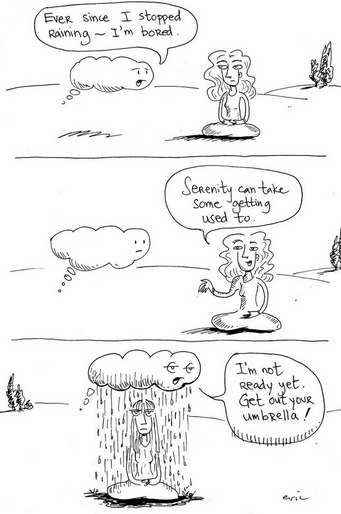We love your questions! Here’s one from someone who is curious about the practice of meditation:
Hi Wisdom Heart,
I’m interested in meditation. But, is meditation a way of escaping reality?
Great question. The short answer is, it depends.
On what?
On your intention.
Almost every spiritual practice—whether it’s meditation, mantra, prayer, study, yoga, fasting, pilgrimage, et cetera—can be used as an escape.
It’s all a matter of intent.
Think of intention as a continuum. On one end of the continuum is the desire for relief. On the other end is the commitment to healing. If your intention is primarily relief, it’s likely that you’re using practice as a form of temporary escape from pain and suffering.
There’s nothing wrong with this.
Sometimes relief is exactly what you need.
If you’ve been working too hard—physically, emotionally, creatively—then taking a time‐out to get some relief, rest and renewal is wisdom. If you’re caught up in a volatile, emotional, overwhelming situation, relief can be the best first step.

But relief can’t really. . . um. . . relieve suffering.
That’s not what it’s for. It’s for temporary relief. And temporary relief comes when your attention is distracted from the source of your pain and focused on something else. Anything else.
In terms of relief, it doesn’t matter if your attention is lost in a movie or a crossword puzzle, or whether you’re dancing and chanting at a kirtan concert, sweating through another sun salutation or laser‐focusing on your breath; suffering thoughts and emotions are held in abeyance.
You’re not paying attention to them.
Your attention is elsewhere, and the relief is palpable.
Ahhhhh. . . There’s a blessing in that. The weight of suffering is lined. The drama is quieted. The mind thinks, “It would be so good to stay here—forever.” But this isn’t a forever‐state. It’s temporary, like all induced states of consciousness. Relief is lovely, but, by its very nature, it’s short‐lived.
When the movie, the kirtan, the distraction ends, sooner or later the effects of relief wear off.
It’s inevitable. And then, you’re back face‐to‐face with those suffering thoughts and emotions. The resurfacing of the suffering thoughts and emotions can trigger an ever more intense form of relief‐seeking—which in time dissipates into the familiar pattern of thoughts and emotions.
So, why do those thoughts and emotions keep showing up?
Because they need your attention. They show up to be healed, blessed, transformed by being infused with compassionate, non‐attached, loving awareness. But, when you’re using spiritual practice to seek relief, you’re doing the exact opposite.
That’s the problem with meditation‐as‐relief. It’s an escape strategy. And when you seek to escape thoughts and emotions, you’re not infusing them with loving awareness; you’re denying them what they need to transform.
The painful thoughts and emotions are crying out for attention.
They are crying out for healing attention. What is healing attention? It is attention that turns toward the suffering. It’s attention that infuses painful, wounded thoughts and emotions with the loving awareness that is equal parts:
Compassion
Non‐identification
Balance
Healing attention opens a conduit through which loving awareness can flow, touch and infuse the thoughts and emotions that create suffering.
Loving awareness feels the suffering—fully—without identification. It is this unique quality of being fully present and at the same time non‐identified that dissolves patterns of suffering into clarity, energy and wholeness.
When spiritual practice is focused more on healing than relief, it’s not an escape.
The commitment to heal closes the escape hatch. You can’t pull away, contract, avoid or distract. Healing attention connects the experience of suffering to the current of loving awareness.
This current carries you deeply into the pattern of suffering and then beyond—into Life itself. These words about going beyond suffering, about energy and clarity, like much of spiritual teachings can be enlisted in the service of relief. Notice this. The urge to escape is itself an expression (and perpetuation) of suffering.
The experience of healing rarely conforms to our fantasy of spiritual awakening.
We’d like the process to be all lovey‐dovey, with an ambient music soundtrack and soft lighting. But, in practice, the knots of suffering that we’ve tied in our body/mind don’t always let go with a contented sigh.
Sometimes they fight back. Tighten up. Rant and rave.
At first, this can throw you back into seeking relief.
But with practice—yes it takes practice—you become more and more capable of keeping the conduit open so that the healing presence of loving awareness can do its work. And then you see more and more clearly that there really is no escape.
You really can’t swim out of the Ocean of Life. But you can release the patterns of conditioning and discover how to be moved by the deep currents.
Whether meditation is escapism or not depends on your intention.
What about you?
Are you leaning more toward relief or healing at this time in your practice? Share below.
~
Relephant Read:
Will Meditation Help me Fall in Love?
~
Author: Eric Klein
Editor: Toby Israel
Images: Courtesy of Author
~







Read 1 comment and reply